 According to the most recent IDES statistics, there are now 83627 different grades of plastics. Often, the difference between two grades of the same basic resin can be as little as one or two percentage points in the proportion of one co-polymer over the other. This may be due to minor changes in levels of polymerization and cross-linking of the polymer chains or to the addition of very small quantities of lubricants and other additives. Unfortunately, these differences, however small, can negatively impact the intended end product, from both a price and performance perspective. Now, there is an easy, cost-effective, palm-sized solution that significantly reduces the incidence of misidentification: RAPID•ID™, designed by DeltaNu, the leader in handheld materials identification instruments.
According to the most recent IDES statistics, there are now 83627 different grades of plastics. Often, the difference between two grades of the same basic resin can be as little as one or two percentage points in the proportion of one co-polymer over the other. This may be due to minor changes in levels of polymerization and cross-linking of the polymer chains or to the addition of very small quantities of lubricants and other additives. Unfortunately, these differences, however small, can negatively impact the intended end product, from both a price and performance perspective. Now, there is an easy, cost-effective, palm-sized solution that significantly reduces the incidence of misidentification: RAPID•ID™, designed by DeltaNu, the leader in handheld materials identification instruments.
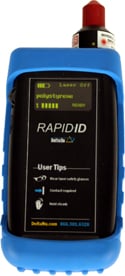
RAPID•ID uses Raman spectroscopy to accurately identify minute differences in plastics in a matter of seconds. RAPID•ID is a molecular analysis tool that quickly and easily scans the material for all the covalent bonds on a sample, and detects differences in the chemical make-up, even if very small. This lightweight, palm-sized tool then compares the results from any tested sample against a set of library spectra in memory. Identifications are determined using a differential correlation matching algorithm.
When the materials are too similar, the user can choose three different methods to enhance the matching algorithm. First, the algorithm can be taught to examine particular regions of the spectra and determine the presence or absence of peaks; second, users teach the algorithm to calculate the ratio of peaks in pre-determined locations and set thresholds for positive or negatives matches, and, third, the user can set the algorithm to emphasize the correlation in a specific sub-region or regions (e.g. “blocks”) of the spectra to confirm or negate the closeness of the match to a particular reference.
These methods can be used separately or together in tandem. Following is a description of all three methods.
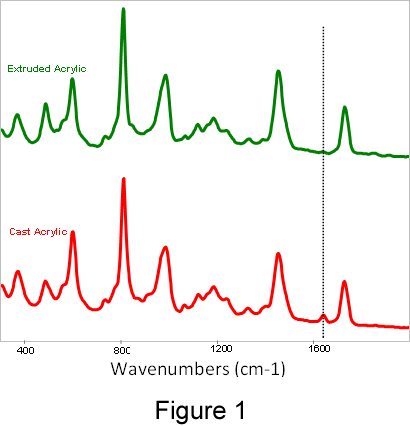 Acrylic, or Polymethyl methacrylate (PMMA) is a very common plastic resin with a myriad of applications. It is usually polymerized and pelletized and then used in most common molding processes. When high-quality PMMA sheets are required, they can be produced by cell casting, in which case the polymerization and molding steps occur concurrently. These sheets tend to have much higher strength and the price difference between cast and regular acrylic can be as much as five times.
Acrylic, or Polymethyl methacrylate (PMMA) is a very common plastic resin with a myriad of applications. It is usually polymerized and pelletized and then used in most common molding processes. When high-quality PMMA sheets are required, they can be produced by cell casting, in which case the polymerization and molding steps occur concurrently. These sheets tend to have much higher strength and the price difference between cast and regular acrylic can be as much as five times.
Chemically, both products are virtually identical and can be very difficult to differentiate using standard methods such as burning and sniffing. However, RAPID•ID with Raman technology can detect the difference even when their chemical composition appears to be the same. A peak is clearly visible in the 1,621cm-1 region (Figure 1). A standard correlation algorithm will yield very high correlations between cast and regular acrylic, of 96% or higher, between the two types. This is because most of the region of interest in both spectra is basically identical. With the use of the secondary matching algorithm, RAPID•ID can easily separate the two materials to achieve a 99% or higher accuracy in tests using the “Find peak” algorithm.
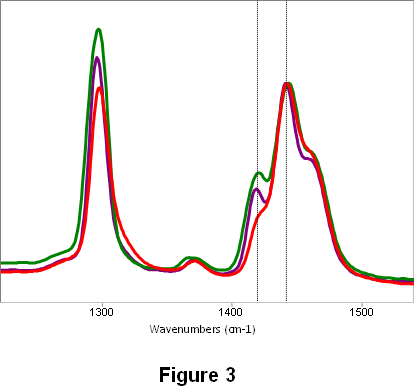 This may increase the possibility of false positives or negatives when testing one against the other. By calculating the ratio of the main peak at 1,441cm-1 to the one at 1,420cm-1 (Figure 3), and implementing it as a secondary test method, the accuracy of the test can be reliably increased to 99% or higher.
This may increase the possibility of false positives or negatives when testing one against the other. By calculating the ratio of the main peak at 1,441cm-1 to the one at 1,420cm-1 (Figure 3), and implementing it as a secondary test method, the accuracy of the test can be reliably increased to 99% or higher.
The peak ratios can be used to differentiate between the three polyethylene samples in this study (see Table 2). There is no overlap of the ranges, which results in very high accuracy. The ratio of the peak centered around 1296cm-1 to the one centered around 1420cm-1 can also be used as a benchmark.
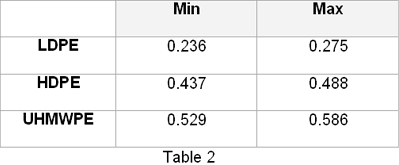
2. Block Matching
The intensity of the peaks in a Raman spectrum is strongly correlated to the number, type and orientation of covalent bonds present in a sample. Sometimes different suppliers of the same material will have slight differences in the recipes that they use to polymerize their products. This can result in small differences in the relative intensity of some peaks in the spectrum relative to others. RAPID•ID can be set up to determine the ratio of one peak relative to another and thus obtain a higher degree of confidence about the match.

To illustrate the recipe differences, samples of four different PVC suppliers were tested. The samples from suppliers A & B are visibly similar to each other. However, supplier B’s product was reverse-engineered from supplier A. Both are clearly different from the samples from C and D, which also are very similar to each other (Figure 4). The correlations between these four samples indicate differences (Table 3).
An extrusion company that was using supplier C material was experiencing difficulties with the processing characteristics of supplier D’s material, and they needed to understand if there was a difference between the two.
Using the standard matching algorithm, RAPID•ID can distinguish between the two groups (A and B versus C and D). However, a more advanced matching method is required to differentiate between the two suppliers in each group. In this particular case, a closer look at the overlapped spectra of the samples from supplier A and B as well as C and D shows that there is a significant difference in the wavenumber region from 980 to 1,050cm-1 (Figures 5 and 6) as well as the region from 800 to 925cm-1.
An advanced library was set up that would require a minimum matching threshold of 90% correlation for each block before returning a positive result.
The block matching differentiates between samples C and D, as the region from 800 to 925 cm-1 only showed a correlation of 69%. (Table 4). However, this region was not as good a benchmark as expected, as both A and B were highly correlated in that block, at 92%.

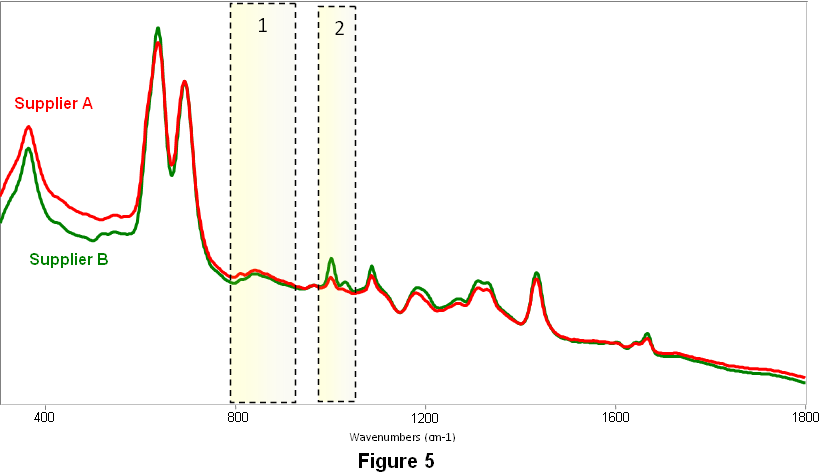
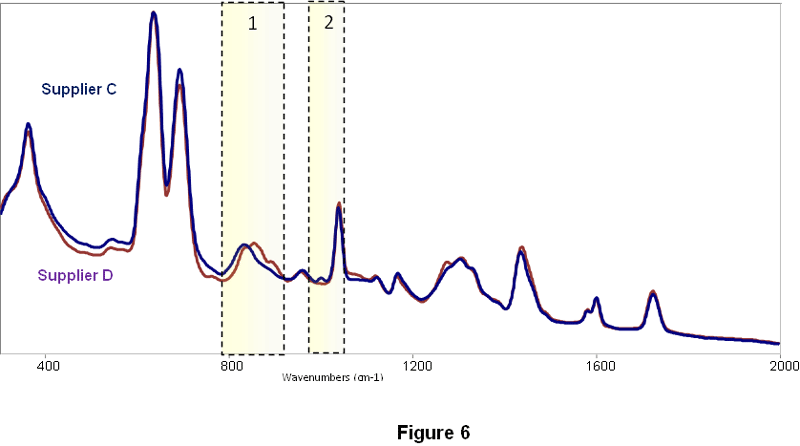
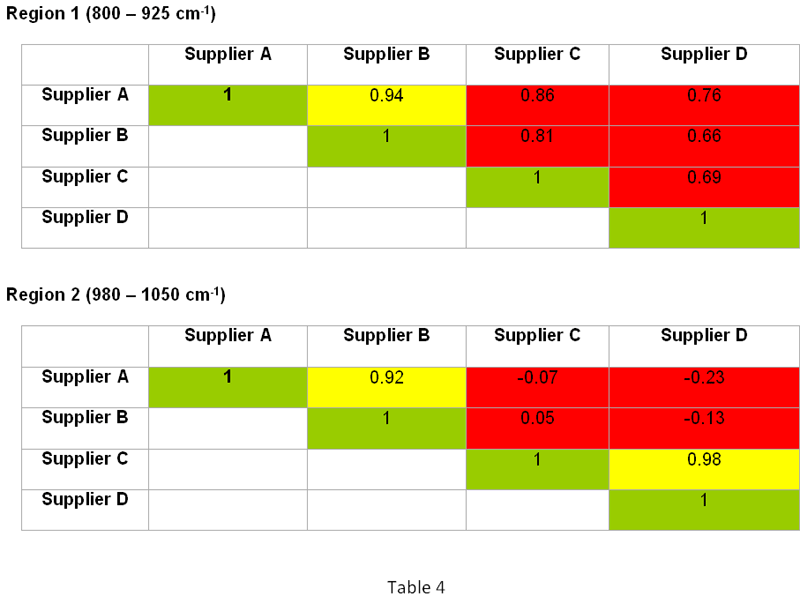
This required a third condition to be added to the library, namely a test for the ratio of the peaks at 1,000cm-1 and the one at 1,433cm-1. After addition of this rule, the accuracy of the overall test was increased to 99%.
Count on RAPID•ID to meet your most complex plastics ID challenges
RAPID•ID will quickly become a valuable quality control tool for materials inspection when used together with DeltaNu’s advanced matching software. This precision system enables companies to better understand the reasons why materials that seem identical behave differently than expected and will give you the technology to ensure that your suppliers are in complete compliance with your specified formulations. The advanced libraries are easy to set up and will work both on the PC software and the unit itself in the field and can be modified to accommodate changes in the material specifications. RAPID•ID is a vital tool for making sure your customers are getting the exact material they order.
For more information about how RAPID•ID can quickly and accurately identify even the most minor differences in the make-up of plastic materials while lowering your costs, call 1-866-301-6328 or email rapidid@deltanu.com
The views, opinions and technical analyses presented here are those of the author or advertiser, and are not necessarily those of ULProspector.com or UL Solutions. The appearance of this content in the UL Prospector Knowledge Center does not constitute an endorsement by UL Solutions or its affiliates.
All content is subject to copyright and may not be reproduced without prior authorization from UL Solutions or the content author.
The content has been made available for informational and educational purposes only. While the editors of this site may verify the accuracy of its content from time to time, we assume no responsibility for errors made by the author, editorial staff or any other contributor.
UL Solutions does not make any representations or warranties with respect to the accuracy, applicability, fitness or completeness of the content. UL Solutions does not warrant the performance, effectiveness or applicability of sites listed or linked to in any content.


